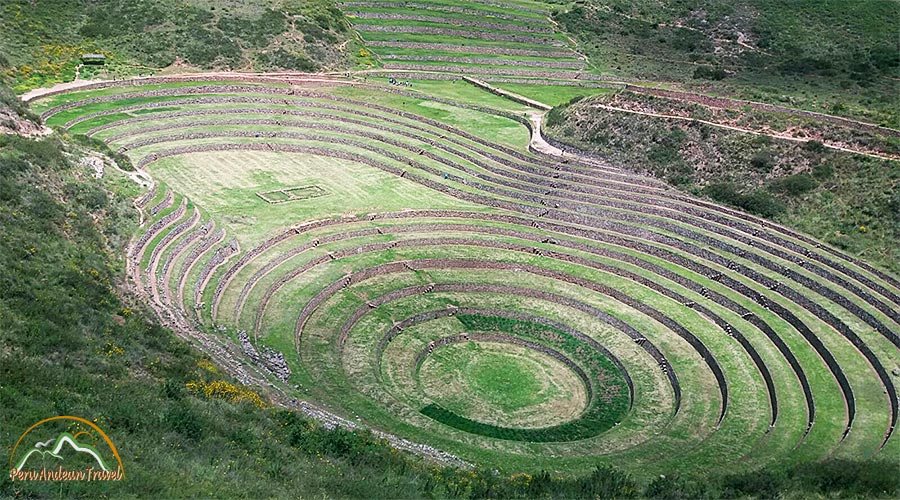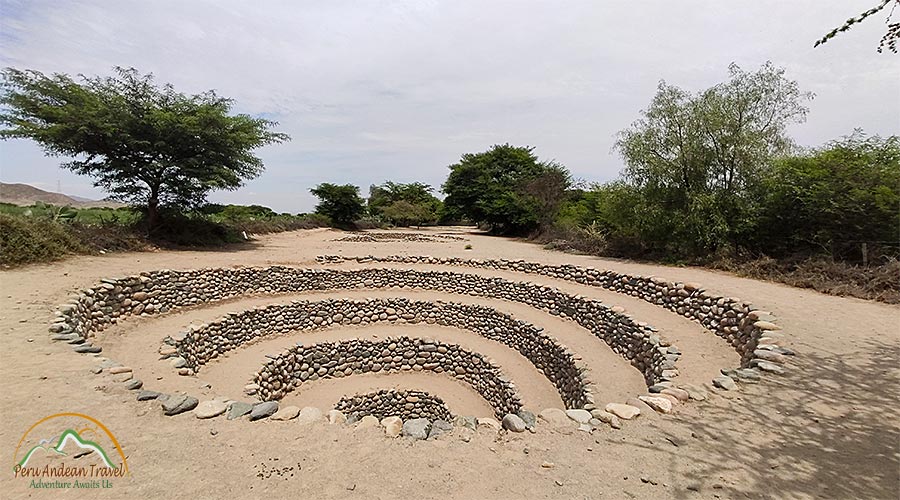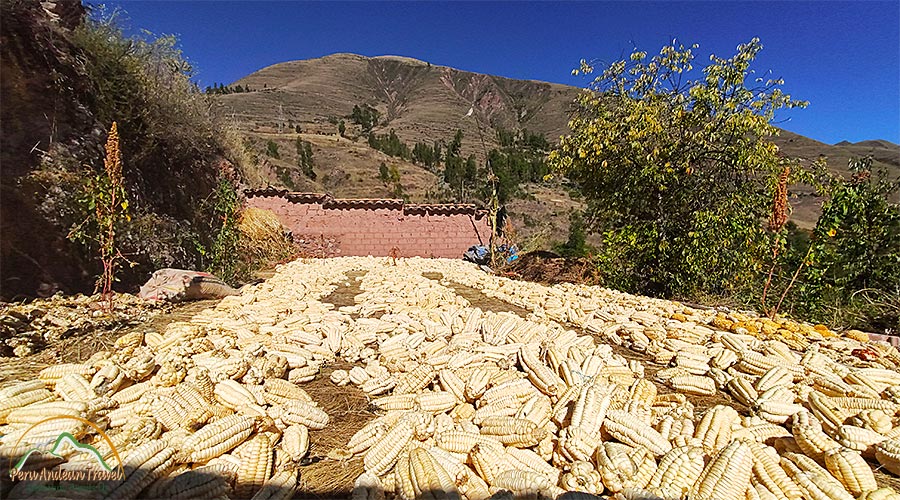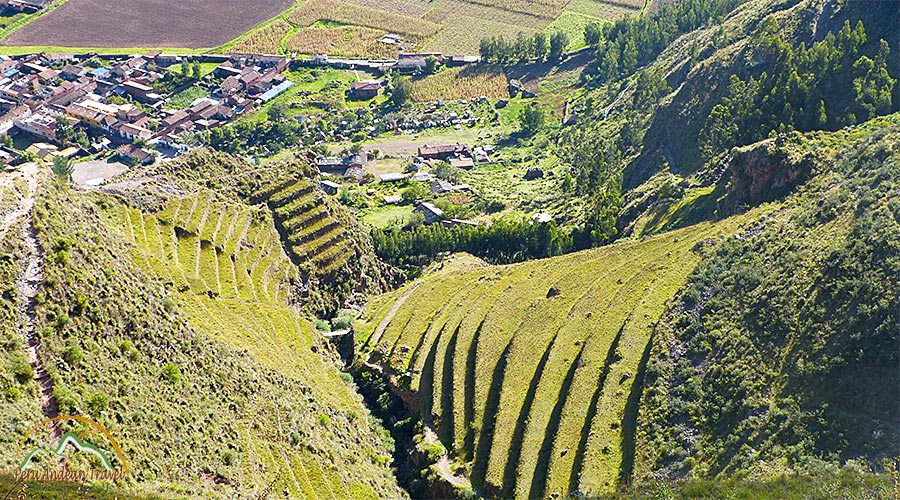Andean agriculture was important in America, it was a fundamental base of the Inca and pre-Inca economy. Agriculture was the food sustenance of many peoples in America and thanks to this activity the pre-Inca peoples managed to adapt, improve and create new varieties of seeds.
Peru farming dates back 10 000 years. In the highlands, and particularly in Cusco city and region, agriculture is believed to have started up between the fifth and fourth millenium BC in the temperate valleys.This early form of farming was basically limited to gathering roots and wild fruits and vegetables, and planting some seeds but without the use of irrigation. Squash, beans, peanuts, aji chili pepper, maize, potato, achira and lucuma fruit were possibly the first products to have been planted.
Throughout the difficult process of adapting to Peru's complex highland geography, which took around 2 000 years, Andean Man came up with ideas on how to make the best use of the different types of soil and how to improve the quality of his crops. Ancient Peruvians also developed the art of rearing Livestock, breeding species of camelus such as the llama and alpaca that were also used as beasts of burden and sources of materials such as wool and leather.
The gradual domestication of plants enabled the first villages to ensure a regular food supply for their growing populations. By the time the first civilizations had crafted pottery and weaving techniques, during the second millennium BC, Andean Man had already figured out how to make use of the rugged highland geography for agriculture and how to influence the natural evolution of species via selection, developing hybrids and employing other techniques.
Andean Agriculture Achievements
The Andes mountain Range was an important center of agricultural development that spread across the rest of South America. Andean people proved to be greatly skilled in domesticating plants in the various microclimates in the surrounding region. They planted several different varieties of potato, maize, the olluco and oca tubers and the grain quinoa, even in frigid highland areas above 3 500 m.s.n.m.
By exposing tubers such as chuño and moraya (freeze-dried potato) and cahui (oca) to natural freezing and then drying, the inhabitants produced longer-lasting products with a higher nutritional value.
Andean farmers domesticated more than 500 species of food staples, including tubers and roots such as potato, oca, olluco, añu or mashua, sweet potato, manioc root, uncucha, yacon, arracacha, achira, jikima, maca and mawk'ka; while bean and grain varieties included frijol, peanuts and lima beans, and tarwi, maize, quinoa, cañihua, amaranth, and puhuru; as well as fruit:
squash, zucchini, lakahuiti, caigua, rocoto, sacha-tomato, tumbo, pepino, jenadine, guayaba, pacay and cucumbers.The Coca leafs were held in high appreciation for the stimulant properties achieved through chewing the plants' leaves.
Nowadays, Potato is one of the world's four leading crops along with maize, wheat and rice. In the Andes, the ancient Peruvians produced seven domesticated species of potato, with around 5 000 varieties and more than 200 wild species. Varieties eaten since pre-Hispanic times include the alccaihuarmi (round, floury and white), cholla huaccoto (flat, small and with a yellow core) and pucamama (round, with a purple skin, red pulp and a yellow core). In comparison, in the rest of the world there are only 750 known varieties.
Maize, or Sara in Quechua, was a vital foodstuff for ancient Peruvians, not only for its nutritional value but also because the kernels could be stored and ground into flour. Today, sweet corn is planted all over the world. Andean Man cultivated maize in different climates.
Cornstalks reached 1.5 meters in height and the plants produced ears of corn year round. Several varieties of corn were grown in pre-Hispanic times, including capia, culli, muruchuo and others. Corn was consumed, and still today, as choclo (tender kernels), mote (cooked and peeled kernels), cancha (toasted kernels) or chochoca (cooked and ground kernels). Since the dawn of time, corn has been used to make chicha or aj'a, a fermented beverage used in religious festivals.
Inca Agriculture
The Incas improved the supply of irrigation water with drainage and networks of canals, controlled flooding with dikes and dams, and built large-scale terraces for soil conservation. They used natural fertilizers, stored and selected seeds and shoots and used, as their basic tool, the taclla, or chaquitaclla, a rustic one-man plough that did not require oxen.
Water and farming chores are important, directed by the panacas or royal clans was organized among the various ayllus or communities that had settled the sacred valley of the incas. The Ayllus carried out community work and subsistence agriculture with methods based on reciprocity such as the minka and ayni.
Their duties also included feeding the Inca's court, his servants, the administrative and religious hierarchy and the army. Inca agriculture was based on a ritual calendar of great religious importance. For example, the Uma Raymi Quilla ceremony (in October) to plead for rain, included sacrificial rituals. The Aymoray Quilla (in May) celebrated the harvest, giving thanks to Pachamama, the earth goddess. The Inti Raymi festival (still celebrated every June in Cusco) worshipped the sun as the protector of fertility.
Distribution of irrigation water also had religious harmonic. It complemented the ceques system, an imaginary network of lines of sacred water that irradiated from the main temple, Qoriqancha, and connected the huacas or sacred sites that were dotted around the empire.
Many Inca agriculture achievemems continue to be the basis of agricultural activity in the Cusco area and many highland regions. There are numerous places in Cusco and its environs where one can find ancient feats of engineering related to this activity.

The set of Inca terraces and complex irrigation system via aqueducts and canals at Tipon, Pisac and Zurite terrace and circular terracing at Moray are indispensable visits for travelers who wish to take in this extraordinary aspect of the Inca Civilization.
Nowadays, the tourist offer in Cusco is varied, one of the tourist products in which we can directly experience Andean agriculture is the agrotourism that takes place in the Cusco region, also some religious festivals are related to agriculture such as The Feast of the Lord of Qoyllority.
Depending on the season of the year, one can carry out different agricultural activities such as preparing the land, planting and harvesting or harvesting; agrotourism can be done in the sacred valley of the Incas and the southern valley of Cusco.
FAQs Andean Agriculture
What is Andean agriculture?
Andean agriculture is a farming practice that dates back more than 10,000 years in the Andean region. It was the fundamental basis of the economy for pre-Inca and Inca civilizations, who cultivated a variety of products adapted to the mountainous geography, such as potatoes, corn, quinoa, and other tubers.
How did Andean agriculture begin?
Andean agriculture began in the inter-Andean valleys between the fifth and fourth millennia BC, when the first communities started domesticating plants such as pumpkins, corn, and potatoes, adapting to the geographic conditions of the highlands.
What are the most important agricultural products of Andean agriculture?
Some of the most important agricultural products in Andean agriculture include potatoes, corn, quinoa, beans, oca, olluco, maca, and achira. These products were cultivated in different microclimates of the Andean region, and many of them were domesticated by pre-Inca civilizations.
What is Andean technology for aqueducts and terraces?
Andean aqueduct and terrace technology was one of the greatest innovations of the ancient Peruvians. They used irrigation systems, channels, and aqueducts to control flooding and distribute water to agricultural areas. They also built terraces (andenes) in the mountains to maximize the use of agricultural land.
How did Andean agriculture contribute to Inca civilization?
Andean agriculture was the foundation of the Inca Empire's economy, providing food for the empire's population and sustaining the communal labor system. The Incas implemented advanced cultivation techniques in the highlands, such as the creation of terraces and the use of natural fertilizers to ensure food production.
What crops were predominant in Inca agriculture?
The predominant crops in Inca agriculture included potatoes, corn, quinoa, cañihua, yucca, oca, and sweet potato. Additionally, the Incas cultivated a wide variety of tubers, grains, and fruits adapted to the climatic conditions of the highland regions of the Andes.
What is chuño and how was it produced?
Chuño is freeze-dried potato produced by exposing potatoes to natural freezing in the high mountains and then drying them in the sun. This conservation process allowed ancient Peruvians to store food for long periods and increase its nutritional value.
How did the Incas manage water for agriculture?
The Incas developed an advanced irrigation system using channels, dikes, and reservoirs to control the flow of water and distribute it efficiently across agricultural fields. These systems allowed Andean farmers to cultivate on mountainous land and optimize water use.
What are "kanchas" in Andean agriculture?
"Kanchas" were agricultural units in Inca times, formed by rectangular areas surrounded by stone walls. Inside, there were several single-story buildings that housed families and served as workspace and storage for crops.
What crops are still grown today in Andean agriculture?
Today, Andean agriculture still grows traditional products such as potatoes, corn, quinoa, and other tubers like oca, olluco, and achira. Additionally, farmers continue to use many of the ancestral farming techniques in the highlands, including terraces and irrigation systems.








Leave us your comment